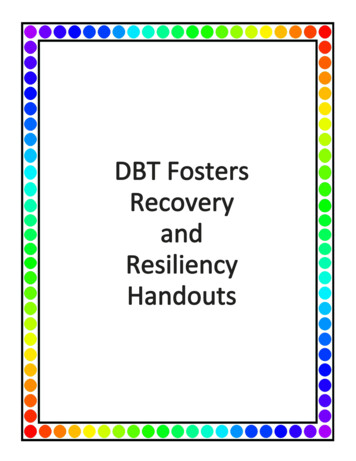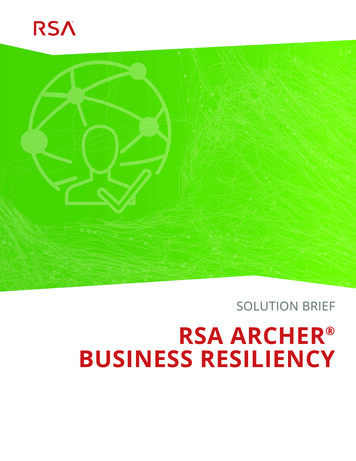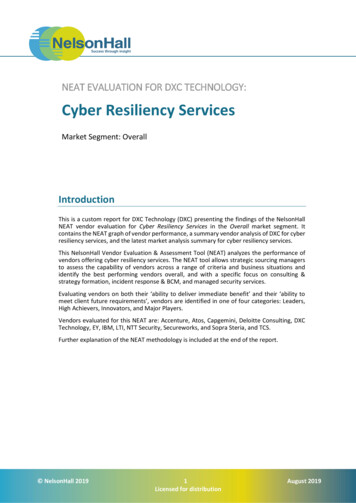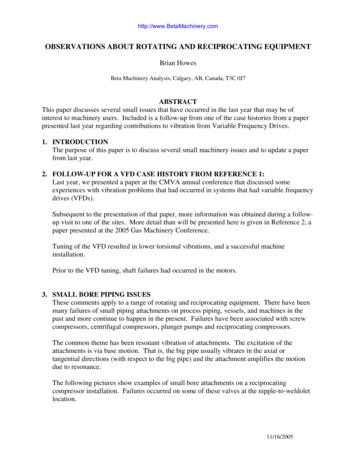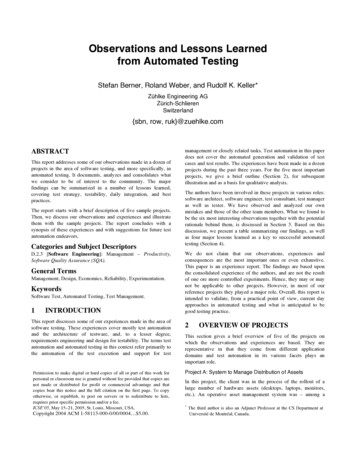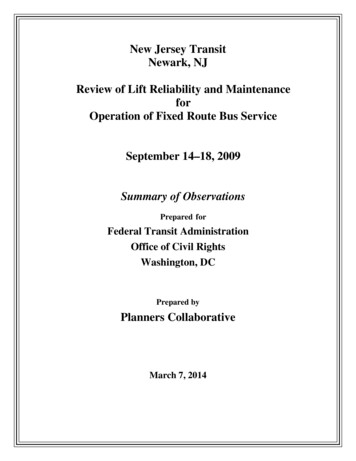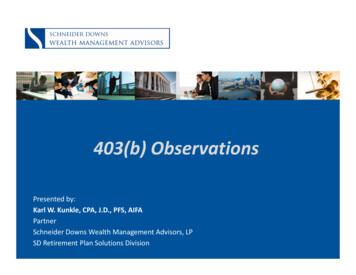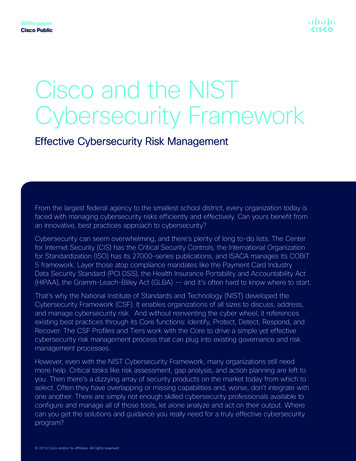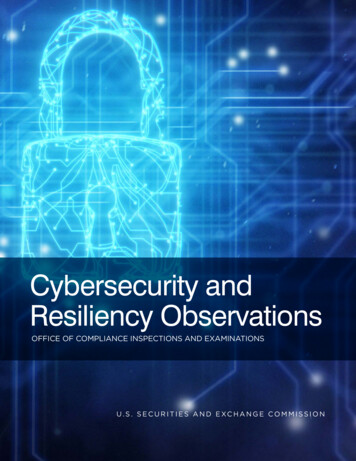
Transcription
Cybersecurity andResiliency ObservationsOFFICE OF COMPLIANCE INSPECTIONS AND EXAMINATIONSU . S . S E C U R I T I E S A N D E XC H A N G E C O M M I S S I O N
CONTENTSGovernance and Risk Management. 2Access Rights and Controls. 3Data Loss Prevention. 4Mobile Security. 6Incident Response and Resiliency. 6Vendor Management. 8Training and Awareness. 9Additional Resources. 9Conclusion. 10DISCLAIMER: This statement represents the views of the staff of the Office of Compliance Inspections and Examinations(OCIE). It is not a rule, regulation, or statement of the U.S. Securities and Exchange Commission. The Commission hasneither approved nor disapproved its content. This statement, like all staff guidance, has no legal force or effect: it doesnot alter or amend applicable law, and it creates no new or additional obligations for any person.
OCIE CYBERSECURITY AND RESILIENCY OBSERVATIONS 1Cybersecurity threats come from many sources, are global in nature, and do notdiscriminate across the spectrum of securities and financial markets and marketparticipants. The seriousness of the threats and the potential consequences toinvestors, issuers, and other securities market participants, and the financial markets andeconomy more generally, are significant and increasing. As markets, market participants,and their vendors have increasingly relied on technology, including digital connections andsystems, cybersecurity risk management has become essential. Indeed, in an environmentin which cyber threat actors are becoming more aggressive and sophisticated—and in somecases are backed by substantial resources including from nation state actors—firms participating in the securities markets, market infrastructure providers and vendors should allappropriately monitor, assess and manage their cybersecurity risk profiles, including theiroperational resiliency.The SEC has focused on cybersecurity issues for many years, with particular attention tomarket systems, customer data protection, disclosure of material cybersecurity risks andincidents, and compliance with legal and regulatory obligations under the federal securities laws.1 Among other things, the SEC maintains a Cybersecurity Spotlight webpagethat provides cybersecurity-related information and guidance.2 Cybersecurity is also a keypriority for OCIE. OCIE has highlighted information security as a key risk for securitymarket participants, and has included it as a key element in its examination program overthe past eight years. OCIE has also published eight risk alerts related to cybersecurity.31For example, the SEC’s Division of Enforcement established the Cyber Unit in September 2017, the SEC hosteda roundtable in 2014 to discuss cybersecurity issues, and the SEC’s Office of Investor Education and Advocacypublished Investor Alerts and Bulletins, such as Investor Alert: Identity Theft, Data Breaches and Your InvestmentAccounts, (Sept. 22, 2015) and Updated Investor Bulletin: Protecting Your Online Investment Accounts from Fraud,(Apr. 26, 2017).2“Spotlight on Cybersecurity, the SEC and You” available at www.sec.gov/spotlight/cybersecurity. This pagecontains information for investors, issuers, and registered firms and organizations, including the CommissionStatement and Guidance on Public Company Cybersecurity Disclosures, guidance from the Division of InvestmentManagement, the Division of Trading and Markets, and Investor Alerts and Bulletins.3See OCIE Safeguarding Customer Records and Information in Network Storage—Use of Third Party SecurityFeatures (May 23, 2019); Investment Adviser and Broker-Dealer Compliance Issues Related to Regulation S-P—Privacy Notices and Safeguard Policies (Apr. 16, 2019); Observations from Investment Adviser ExaminationsRelating to Electronic Messaging (Dec. 14, 2018); Observations from Cybersecurity Examinations (Aug. 7, 2017);Cybersecurity: Ransomware Alert (May 17, 2017); OCIE’s 2015 Cybersecurity Examination Initiative (Sept. 15,2015); Cybersecurity Examination Sweep Summary (Feb. 3, 2015); and Investment Adviser Use of Social Media(Jan. 4, 2012).
2 U.S. SECURITIES AND EXCHANGE COMMISSIONThrough thousands of examinations of broker-dealers, investment advisers, clearingagencies, national securities exchanges and other SEC registrants, OCIE has observedvarious industry practices and approaches to managing and combating cybersecurity riskand the maintenance and enhancement of operational resiliency. These include practicesin the areas of governance and risk management, access rights and controls, data lossprevention, mobile security, incident response and resiliency, vendor management, andtraining and awareness. Recognizing that there is no such thing as a “one-size fits all”approach, and that all of these practices may not be appropriate for all organizations,we are providing these observations to assist market participants in their consideration ofhow to enhance cybersecurity preparedness and operational resiliency.GOVERNANCE AND RISK MANAGEMENTEffective cybersecurity programs start with the right tone at the top, with senior leaderswho are committed to improving their organization’s cyber posture through working withothers to understand, prioritize, communicate, and mitigate cybersecurity risks. While theeffectiveness of any given cybersecurity program is fact-specific, we have observed that akey element of effective programs is the incorporation of a governance and risk management program that generally includes, among other things: (i) a risk assessment to identify,analyze, and prioritize cybersecurity risks to the organization; (ii) written cybersecuritypolicies and procedures to address those risks; and (iii) the effective implementation andenforcement of those policies and procedures.OCIE has observed organizations utilizing the following risk management and governance measures: Senior Level Engagement. Devoting appropriate board and senior leadershipattention to setting the strategy of and overseeing the organization’s cybersecurityand resiliency programs. Risk Assessment. Developing and conducting a risk assessment process to identify,manage, and mitigate cyber risks relevant to the organization’s business. This includesconsidering the organization’s business model, as part of defining a risk assessmentmethodology, and working to identify and prioritize potential vulnerabilities, including remote or traveling employees, insider threats, international operations andgeopolitical risks, among others.
OCIE CYBERSECURITY AND RESILIENCY OBSERVATIONS 3 Policies and Procedures. Adopting and implementing comprehensive written policiesand procedures addressing the areas discussed below and identified risks. Testing and Monitoring. Establishing comprehensive testing and monitoring to validatethe effectiveness of cybersecurity policies and procedures on a regular and frequentbasis. Testing and monitoring can be informed based on cyber threat intelligence. Continuously Evaluating and Adapting to Changes. Responding promptly to testingand monitoring results by updating policies and procedures to address any gaps orweaknesses and involving board and senior leadership appropriately. Communication. Establishing internal and external communication policies andprocedures to provide timely information to decision makers, customers, employees,other market participants, and regulators as appropriate.ACCESS RIGHTS AND CONTROLSAccess rights and controls are used to determine appropriate users for organizationsystems based on job responsibilities, and to deploy controls to limit access to authorizedusers. Access controls generally include: (i) understanding the location of data, includingclient information, throughout an organization; (ii) restricting access to systems and datato authorized users; and (iii) establishing appropriate controls to prevent and monitor forunauthorized access.OCIE has observed strategies related to access rights and controls at organizations thatperform the following: User Access. Developing a clear understanding of access needs to systems and data.This includes limiting access to sensitive systems and data, based upon the user’sneeds to perform legitimate and authorized activities on the organization’s information systems, and requiring periodic account reviews. Access Management. Managing user access through systems and procedures that:(i) limit access as appropriate, including during onboarding, transfers, and terminations; (ii) implement separation of duties for user access approvals; (iii) re-certifyusers’ access rights on a periodic basis (paying particular attention to accounts withelevated privileges including users, administrators, and service accounts); (iv) requirethe use of strong, and periodically changed, passwords; (v) utilize multi-factorauthentication (MFA) leveraging an application or key fob to generate an additionalverification code; and (vi) revoke system access immediately for individuals no longeremployed by the organization, including former contractors.
4 U.S. SECURITIES AND EXCHANGE COMMISSION Access Monitoring. Monitoring user access and developing procedures that:(i) monitor for failed login attempts and account lockouts; (ii) ensure proper handlingof customers’ requests for user name and password changes as well as procedures forauthenticating anomalous or unusual customer requests; (iii) consistently review forsystem hardware and software changes, to identify when a change is made; and(iv) ensure that any changes are approved, properly implemented, and that anyanomalies are investigated.DATA LOSS PREVENTIONData loss prevention typically includes a set of tools and processes an organization uses toensure that sensitive data, including client information, is not lost, misused, or accessed byunauthorized users.OCIE has observed the following data loss prevention measures utilized by organizations: Vulnerability Scanning. Establishing a vulnerability management program that includesroutine scans of software code, web applications, servers and databases, workstations,and endpoints both within the organization and applicable third party providers. Perimeter Security. Implementing capabilities that are able to control, monitor, andinspect all incoming and outgoing network traffic to prevent unauthorized or harmfultraffic. These capabilities include firewalls, intrusion detection systems, email securitycapabilities, and web proxy systems with content filtering. Implementing an enterprisedata loss prevention solution capable of monitoring and blocking access to personalemail, cloud-based file sharing services, social media sites, and removable media suchas USB and CDs. Detective Security. Implementing capabilities that are able to detect threats onendpoints. Considering products that can utilize both signature and behavioralbased capabilities and can identify incoming fraudulent communications to preventunauthorized software or malware from running. Establishing policies and proceduresto capture and retain system logs from systems and applications for aggregation andanalysis. For software that provides automated actions, such as macros and scripts,enabling optional security features or following the security guidance that may beoffered by third party software providers.
OCIE CYBERSECURITY AND RESILIENCY OBSERVATIONS 5 Patch Management. Establishing a patch management program covering all software(i.e., in-house developed, custom off-the-shelf, and other third party software) andhardware, including anti-virus and anti-malware installation. Inventory Hardware and Software. Maintaining an inventory of hardware andsoftware assets, including identification of critical assets and information (i.e., knowwhere they are located, and how they are protected). Encryption and Network Segmentation. Using tools and processes to secure data andsystems, including: (i) encrypting data “in motion” both internally and externally;(ii) encrypting data “at rest” on all systems including laptops, desktops, mobilephones, tablets, and servers; and (iii) implementing network segmentation and accesscontrol lists to limit data availability to only authorized systems and networks. Insider Threat Monitoring. Creating an insider threat program to identify suspiciousbehaviors, including escalating issues to senior leadership as appropriate. Increasingthe depth and frequency of testing of business systems and conducting penetrationtests. Creating rules to identify and block the transmission of sensitive data (e.g.,account numbers, social security numbers, trade information, and source code) fromleaving the organization. Tracking corrective actions in response to findings fromtesting and monitoring, material changes to business operations or technology, andany other significant events. Securing Legacy Systems and Equipment. Verifying that the decommissioning anddisposal of hardware and software does not create system vulnerabilities by usingprocesses to: (i) remove sensitive information from and prompt disposal of decommissioned hardware and software; and (ii) reassess vulnerability and risk assessments aslegacy systems are replaced with more modern systems.
6 U.S. SECURITIES AND EXCHANGE COMMISSIONMOBILE SECURITYMobile devices and applications may create additional and unique vulnerabilities. OCIE hasobserved the following mobile security measures at organizations utilizing mobile applications: Policies and Procedures. Establishing policies and procedures for the use of mobile devices. Managing the Use of Mobile Devices. Using a mobile device management (MDM)application or similar technology for an organization’s business, including emailcommunication, calendar, data storage, and other activities. If using a “bring yourown device” policy, ensuring that the MDM solution works with all mobile phone/device operating systems. Implementing Security Measures. Requiring the use of MFA for all internal andexternal users. Taking steps to prevent printing, copying, pasting, or saving information to personally owned computers, smartphones or tablets. Ensuring the ability toremotely clear data and content from a device that belongs to a former employee orfrom a lost device. Training Employees. Training employees on mobile device policies and effectivepractices to protect mobile devices.INCIDENT RESPONSE AND RESILIENCYIncident response includes: (i) the timely detection and appropriate disclosure of materialinformation regarding incidents; and (ii) assessing the appropriateness of corrective actionstaken in response to incidents. An important component of an incident response planincludes business continuity and resiliency (i.e., if an incident were to occur, how quicklycan the organization recover and again safely serve clients?).OCIE has observed that many organizations with incident response plans tend to includethe following elements: Development of a Plan. Developing a risk-assessed incident response plan for variousscenarios including denial of service attacks, malicious disinformation, ransomware,key employee succession, as well as extreme but plausible scenarios. Considering pastcybersecurity incidents and current cyber-threat intelligence in developing businesscontinuity plans and policies and procedures. Establishing and maintaining procedures that include: (i) timely notification and response if an event occurs; (ii) a processto escalate incidents to appropriate levels of management, including legal and compliance functions; and (iii) communication with key stakeholders.
OCIE CYBERSECURITY AND RESILIENCY OBSERVATIONS 7 Addressing Applicable Reporting Requirements. Determining and complying withapplicable federal and state reporting requirements for cyber incidents or events,such as requirements for financial institutions to file a suspicious activity reportor for public companies to disclose material risks and incidents. For example, theorganization should consider:»» Contacting local authorities or the FBI if an attack or compromise is discoveredor suspected.»» Informing regulators and sharing information, including indicators of compro-mise (artifacts observed on a network or operating system indicating a potentialintrusion), with the appropriate organizations.»» Notifying customers, clients, and employees promptly if their data iscompromised. Assigning Staff to Execute Specific Areas of the Plan. Designating employees withspecific roles and responsibilities in the event of a cyber incident. In doing so,identifying additional cybersecurity and recovery expertise in advance. Testing and Assessing the Plan. Testing the incident response plan and potentialrecovery times, using a variety of methods including tabletop exercises. If an incidentdoes occur, implementing the plan and assessing the response after the incident todetermine whether any changes to the procedures are necessary.OCIE has observed the following strategies to address resiliency: Maintaining an Inventory of Core Business Operations and Systems. Identifying andprioritizing core business services. Understanding the impact on business servicesof an individual system or process failure. Mapping the systems and processes thatsupport business services, including those over which the organization may not havedirect control. Assessing Risks and Prioritizing Business Operations. Developing a strategy foroperational resiliency with defined risk tolerances tailored to the organization. Indeveloping a strategy, organizations consider: (i) determining which systems andprocesses are capable of being substituted during disruption so that business servicescan continue to be delivered; (ii) ensuring geographic separation of back-up dataand avoid concentration risk; and (iii) the effects of business disruptions on both theinstitution’s stakeholders and other organizations.
8 U.S. SECURITIES AND EXCHANGE COMMISSION Considering Additional Safeguards. Maintaining back-up data in a different networkand offline. Evaluating whether cybersecurity insurance is appropriate for the organization’s business.VENDOR MANAGEMENTPractices and controls related to vendor management generally include policies andprocedures related to: (i) conducting due diligence for vendor selection; (ii) monitoringand overseeing vendors, and contract terms; (iii) assessing how vendor relationships areconsidered as part of the organization’s ongoing risk assessment process as well as how theorganization determines the appropriate level of due diligence to conduct on a vendor; and(iv) assessing how vendors protect any accessible client information.OCIE has observed the following practices in the area of vendor management by organizations: Vendor Management Program. Establishing a vendor management program to ensurevendors meet security requirements and that appropriate safeguards are implemented.Leveraging questionnaires based on reviews of industry standards (
4 U.S. SECURITIES AND EXCHANGE COMMISSION Access Monitoring. Monitoring user access and developing procedures that: (i) monitor for failed login attempts and account lockouts; (ii) ensure proper handling of customers’ requests for
